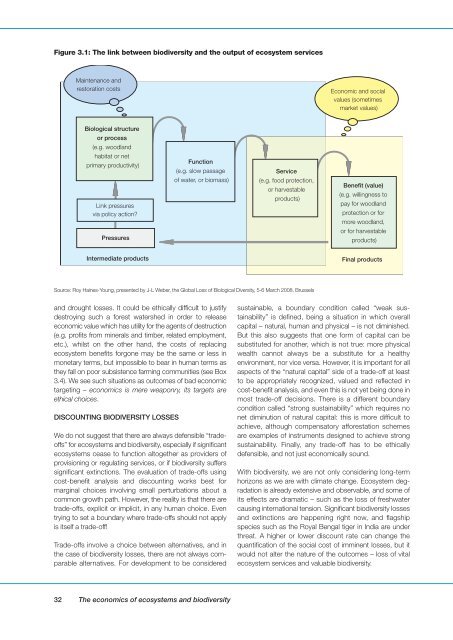Interim Report - TEEB
Interim Report - TEEB
Interim Report - TEEB
Create successful ePaper yourself
Turn your PDF publications into a flip-book with our unique Google optimized e-Paper software.
Figure 3.1: The link between biodiversity and the output of ecosystem services<br />
Maintenance and<br />
restoration costs<br />
Economic and social<br />
values (sometimes<br />
market values)<br />
Biological structure<br />
or process<br />
(e.g. woodland<br />
habitat or net<br />
primary productivity)<br />
Link pressures<br />
via policy action?<br />
Pressures<br />
Function<br />
(e.g. slow passage<br />
of water, or biomass)<br />
Service<br />
(e.g. food protection,<br />
or harvestable<br />
products)<br />
Benefit (value)<br />
(e.g. willingness to<br />
pay for woodland<br />
protection or for<br />
more woodland,<br />
or for harvestable<br />
products)<br />
Intermediate products<br />
Final products<br />
Source: Roy Haines-Young, presented by J-L Weber, the Global Loss of Biological Diversity, 5-6 March 2008, Brussels<br />
and drought losses. It could be ethically difficult to justify<br />
destroying such a forest watershed in order to release<br />
economic value which has utility for the agents of destruction<br />
(e.g. profits from minerals and timber, related employment,<br />
etc.), whilst on the other hand, the costs of replacing<br />
ecosystem benefits forgone may be the same or less in<br />
monetary terms, but impossible to bear in human terms as<br />
they fall on poor subsistence farming communities (see Box<br />
3.4). We see such situations as outcomes of bad economic<br />
targeting – economics is mere weaponry, its targets are<br />
ethical choices.<br />
DISCOUNTING BIODIVERSITY LOSSES<br />
We do not suggest that there are always defensible “tradeoffs”<br />
for ecosystems and biodiversity, especially if significant<br />
ecosystems cease to function altogether as providers of<br />
provisioning or regulating services, or if biodiversity suffers<br />
significant extinctions. The evaluation of trade-offs using<br />
cost-benefit analysis and discounting works best for<br />
marginal choices involving small perturbations about a<br />
common growth path. However, the reality is that there are<br />
trade-offs, explicit or implicit, in any human choice. Even<br />
trying to set a boundary where trade-offs should not apply<br />
is itself a trade-off!<br />
Trade-offs involve a choice between alternatives, and in<br />
the case of biodiversity losses, there are not always comparable<br />
alternatives. For development to be considered<br />
sustainable, a boundary condition called “weak sustainability”<br />
is defined, being a situation in which overall<br />
capital – natural, human and physical – is not diminished.<br />
But this also suggests that one form of capital can be<br />
substituted for another, which is not true: more physical<br />
wealth cannot always be a substitute for a healthy<br />
environment, nor vice versa. However, it is important for all<br />
aspects of the “natural capital” side of a trade-off at least<br />
to be appropriately recognized, valued and reflected in<br />
cost-benefit analysis, and even this is not yet being done in<br />
most trade-off decisions. There is a different boundary<br />
condition called “strong sustainability” which requires no<br />
net diminution of natural capital: this is more difficult to<br />
achieve, although compensatory afforestation schemes<br />
are examples of instruments designed to achieve strong<br />
sustainability. Finally, any trade-off has to be ethically<br />
defensible, and not just economically sound.<br />
With biodiversity, we are not only considering long-term<br />
horizons as we are with climate change. Ecosystem degradation<br />
is already extensive and observable, and some of<br />
its effects are dramatic – such as the loss of freshwater<br />
causing international tension. Significant biodiversity losses<br />
and extinctions are happening right now, and flagship<br />
species such as the Royal Bengal tiger in India are under<br />
threat. A higher or lower discount rate can change the<br />
quantification of the social cost of imminent losses, but it<br />
would not alter the nature of the outcomes – loss of vital<br />
ecosystem services and valuable biodiversity.<br />
32 The economics of ecosystems and biodiversity

















